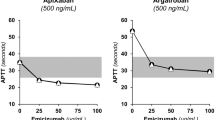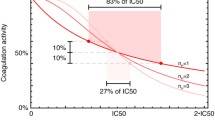Abstract
Introduction
In the treatment of acetaminophen toxicity, clinicians believe that N-acetylcysteine (NAC) artificially elevates prothrombin time (PT). However, the effect of NAC on human blood coagulation remains unverified. In a previous study, we show that NAC had a dose-dependent effect on PT. To our knowledge, there are no studies that specifically examine the mechanism by which NAC affects PT. This study evaluates the effect from a therapeutic NAC dose on the activity of coagulation factors II, VII, IX, and X in human plasma.
Method
We obtained blood samples from ten volunteer subjects. After centrifugation of each volunteer's blood sample, the plasma was pipetted and divided into two 1-mL aliquots. We used the first-1 mL sample as a control. The second 1-mL plasma sample had 5 μL of 20 % NAC, added to make a final concentration of 1,000 mg of NAC per L of plasma. This concentration of NAC approximates the plasma levels achieved after a 150-mg/kg dose. We incubated the two samples for each subject (control and 1,000 mg/L) at 37°C for 1 h and measured the activity of coagulation factors II, VII, IX, and X. We compared factor activity using the paired student t test.
Results
Participants included ten healthy subjects; six males, four females, median age 31 years. Mean values of the control samples for factors II, VII, IX, and X were 134 (CI 119–149), 126 (CI 90–163), 137 (CI 117–157), and 170 (CI 144–196) %, respectively. Mean values of the NAC-containing samples for factors II, VII, IX, and X were 90 (CI 79–100), 66 (CI 51–80), 74 (CI 63–85), and 81 (CI 71–90) %, respectively. All samples containing NAC had significantly lower coagulation factor activity level than their controls with a p < 0.001.
Discussion
In a previous study, we were able to demonstrate that NAC had a dose-dependent effect on PT. In this study, we compared activity of factors II, VII, IX, and X at baseline and for samples that received NAC. All factor activity had a significant decrease with the addition of NAC. This fall in factor activity is not explained by the dilution of adding NAC to the test samples.
Conclusion
We are able to demonstrate a significant decrease in the activity of coagulation factors II, VII, IX, and X with the addition of NAC. This may be the mechanism by which PT increased in our previous study.

Similar content being viewed by others
References
Acetadote package insert. Nashville, TN, Cumberland Pharmaceuticals, Inc., March 2004
Hoffmann U, Fischereder M, Kruger B (2004) The value of N-acetylcysteine in the prevention of radiocontrast agent-induced nephropathy seems questionable. J Am Soc Nephrol 15:407–410
Meredith TJ, Ruprah M, Liddle A et al (1989) Diagnosis and treatment of acute poisoning with volatile substances. Hum Toxicol 8(4):277–286
Whyte IM, Buckley NA, Reith DM et al (2000) Acetaminophen causes an increased international normalized ratio by reducing functional factor VII. Ther Drug Monit 22:742–748
Thijssen HH, Soute BA, Vervoort LM et al (2004) Paracetamol (acetaminophen) warfarin interaction: NAPQI, the toxic metabolite of paracetamol, is an inhibitor of enzymes in the vitamin K cycle. Thromb Haemost 92:797–802
Schmidt LE, Knudsen TT, Dalhoff KP et al (2002) Effect of N-acetylcysteine on prothrombin index in patients with uncomplicated paracetamol poisoning. Lancet 360(9340):1151–1152
Lucena MI, Lopez-Torres E, Verge C (2005) The administration of N-acetylcysteine causes a decrease in prothrombin time in patients with paracetamol overdose but without evidence of liver impairment. Eur J Gastroenterol Hepatol 17:59–63
Harrison PM, O'Grady JG, Keays RT et al (1990) Serial prothrombin time as prognostic indicator in paracetamol-induced fulminant hepatic failure. BMJ 301:964–966
Bernal W, Wendon J, Rela M et al (1998) Use and outcome of liver transplantation in acetaminophen-induced acute liver failure. Hepatology 27:1050–1055
Riordan SM, Williams R (2000) Use and validation of selection criteria for liver transplantation in acute liver failure. Liver Transpl 6:170–173
Pizon AF, Jang DH, Wang HE (2011) The in vitro effect of N-acetylcysteine on prothrombin time in plasma samples from healthy subjects. Acad Emerg Med 18(4):351–354
Prescott LF, Donovan JW, Jarvie DR et al (1989) The disposition and kinetics of intravenous N-acetylcysteine in patients with paracetamol overdosage. Eur J Clin Pharmacol 37(5):501–506
Selden BS, Curry SC, Clark RF et al (1991) Transplacental transport of N-acetylcysteine in an ovine model. Ann Emerg Med 20(10):1069–1072
Thorsen S, Teisner A, Jensen SA et al (2009) Effect of N-acetylcysteine on the accuracy of the prothrombin time assay of plasma coagulation factor II+VII+X activity in subjects infused with the drug. Influence of time and temperature. Scand J Clin Lab Invest 69(6):643–650
Frison L, Pocock SJ (1992) Repeated measures in clinical trials: analysis using mean summary statistics and its implications for design. Stat Med 11:1685–1704
Geisser S, Greenhoiuse S (1958) An extension of Box’s results on the use of the F distribution in multivariate analysis. Ann Math Stat 29:885–891
Jepsen S, Hansen AB (1994) The influence of N-acetylcysteine on the measurement of prothrombin time and activated partial thromboplastin time in healthy subjects. Scand J Clin Lab Invest 54:543–547
Niemi TT, Munsterhjelm E, Poyhia R et al (2006) The effect of N-acetylcysteine on blood coagulation and platelet function in patients undergoing open repair of abdominal aortic aneurysm. Blood Coagul Fibrinolysis 17(1):29–34
Beckett GJ, Donovan JW, Hussey AJ et al (1990) Intravenous N-acetylcysteine, hepatotoxicity and plasma glutathione S-transferase in patients with paracetamol overdosage. Hum Exp Toxicol 9(3):183–186
Acknowledgments
This study is supported in part by grant 5UL1RR029893 from the National Center for Research Resources, National Institutes of Health, the American Academy of Clinical Toxicology Research Award (Jang DH), and the Pittsburgh Emergency Medicine Foundation (PEMF).
Author information
Authors and Affiliations
Corresponding author
Rights and permissions
About this article
Cite this article
Jang, D.H., Weaver, M.D. & Pizon, A.F. In Vitro Study of N-acetylcysteine on Coagulation Factors in Plasma Samples from Healthy Subjects. J. Med. Toxicol. 9, 49–53 (2013). https://doi.org/10.1007/s13181-012-0242-2
Published:
Issue Date:
DOI: https://doi.org/10.1007/s13181-012-0242-2




